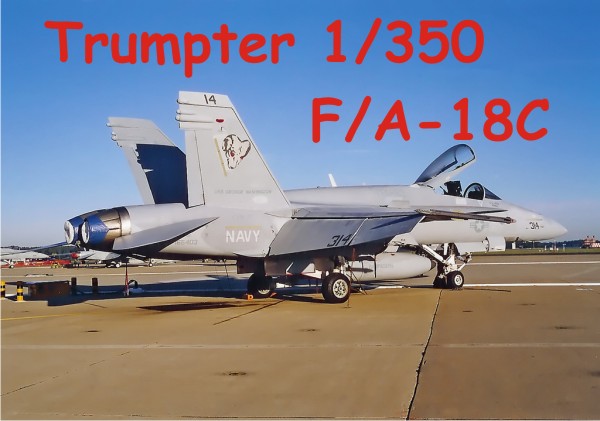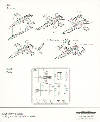
Reviewed by Jon Somerville |
||||
|
As far as aircraft development goes, the story of the F/A-18 is rather unique. The Navy was offered a derivate of the F-16 but the US Navy had more requirements than the F-16 could offer such as two engines. The Navy requested McDonnell Douglas and Northrop design the F-18 a fighter largely based on the YF-17, the aircraft the USAF declined in preference for the F-16. In the end the F-18 was nothing like the YF-17 in its dimensions or structure. By 1980 the Hornet was being referred to as the F/A-18 where initial plans were to buy dedicated F-18s and A-18s. Northrop, which was to perform export sales backed out around 1985 when McDonnell Douglas made more success selling the standard F/A-18. Production models of the new F/A-18C started coming off the line in 1987. Export sales have been high for a specialized naval aircraft. Countries such as Canada, Australia, Finland, Kuwait, Spain, Switzerland and Malaysia have all taken possession of the F/A-18. At this time the Navy is seeking to replace the F/A-18 with the F-35C but no exact dates have been set. With new F/A-18E/Fs and EA-18Gs coming off the assembly line will ensure that a Hornet in some form is on a US carrier deck for years to come. | ||||
| KIT | ||||
|
This kit was released onto the market in August of 2007 along with other 1/350 Hornets, the F/A-18D and F/A-18F. Like all current Trumpeter 1/350 aircraft releases, this set comes with six aircraft. Most noticeable is the all clear plastic of which these aircraft are made. If any one remembers that TV show and the animated show with Wonder Woman, you will recall she flew an invisible jet. These F/A-18s in clear plastic certainly reminded me of that show. However, this clear plastic is often not liked as the plastic itself is brittle and harder see to clean up. Most people paint them right away so they can see the parts they are working with. I too am not a fan of this production plastic. However, even though these F/A-18s molded in clear plastic, it is very well detailed, accurate looking and go together with ease and quickly. During assembly, watch the fit on the intakes as they didn't fit as well on mine but mostly the problem areas were on the bottom of the fuselage, out of site. To overcome the clear plastic issues I thought about gluing the main components together and airbrushing them to find and sand out any seems. In the end I sanded them down best I could see on the clear plastic, then used Mr. Surface to help me fill in the cracks. This was fast and worked very well and saved me time on the airbrush. They're really aren't many seems and you will want to make sure your fit is good and accurate before you apply your glue. Defiantly work in bright light. I wanted to compare these Trumpeter Hornets to the Tamyia counterparts so grabbed them down off the shelf. The Tamyia ones are nice, but are molded based on the prototypes so have the saw tooth in both the wings and the horizontal stabilizers, which is a pain to clean up. Canopy is not a separate part so a modeler will require more skill to display with the canopy open. If you are not including a cockpit, I would suggest painting the inside walls and floor of the aircraft black as the aircraft is clear plastic and the outside paint will show inside. For the main gear, I will use the kit parts as they are mostly hidden. They fit well and will be stronger than photoetch in my opinion. For the nose gear I will definitely replace with photoetched parts. A nice feature to this kit is external fuel drop tanks. I will add some scratch built fuel tanks for the centerline pylon for some of my aircraft. But the other added bonus to this kit is the empty pylons. They don't come with any weapons attached but these can be scratch built if needed but are often empty. I assembled some of the aircraft and they went together very easily. I didn't need any nose weight to keep the nose gear on the ground. |
to enlarge |
|||
 |
||||
|
||||
| DECALS | ||||
|
Markings are for VF-195 'Dambusters.' It provides the same markings for all six aircraft. As it is only for the CO bird, you will want to print your own modex numbers and standard low-viz markings or purchase aftermarket decals. For most, these decals provided will be useless. |
 |
|||
| INSTRUCTIONS | ||||
|
Just like all the other 1/350 aircraft kits by Trumpeter, because of the simplicity of the build, the instructions are on the back of the box. |
 |
|||
| CONCLUSIONS | ||||
|
Even though the kit is advertised as the F/A-18C, it would be still useful to use as an F/A-18A as there is little external difference and at this scale it would not be noticed. I think this kit is superb, looks accurate and goes together quickly and easily. I was surprised that a kit composed entirely of clear plastic worked with decent results. Fortunately the design of the aircraft and kit required very little sanding of seams. The only con in my opinion was that the canopy was not a separate part so that the model could be displayed with the canopy open. Although not necessary, I do recommend purchasing some aftermarket photo etch to make this aircraft look its best. At this point, your options are the Tamiya or the Trumpter kits. I would recommend the Trumpter 1/350 F-18C offering for your modern USN Aircraft Carrier. |
||||



